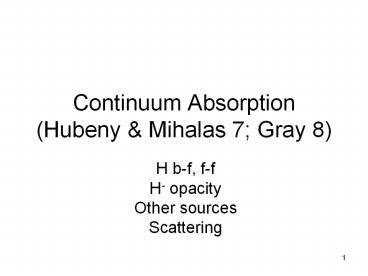Continuum Absorption (Hubeny - PowerPoint PPT Presentation
Title:
Continuum Absorption (Hubeny
Description:
Continuum Absorption (Mihalas 4.4; Gray 8) H b-f, f-f H- opacity Other sources Scattering H bound-free H bound-free H bound-free Final result is sum over all levels ... – PowerPoint PPT presentation
Number of Views:114
Avg rating:3.0/5.0
Title: Continuum Absorption (Hubeny
1
Continuum Absorption(Hubeny Mihalas 7 Gray 8)
- H b-f, f-fH- opacityOther sourcesScattering
2
H bound-free
3
H bound-free
4
H bound-free
- Final result is sum over all levels that can be
ionized by photon of given frequency - Dominant in spectral types B, A
5
H free-free
- Electron moving close to proton
- Photon absorbed energy into velocity of the
electron - Photon emitted energy from velocity of the
electron (bremsstrahlung)
6
H free-free
7
H free-free
8
Negative Hydrogen Ion H-
9
Negative Hydrogen Ion H-
10
Negative Hydrogen Ion H-
- Cannot exist in hot stars because collisions
destroy H- - Cant exist in cool stars because free electrons
needed (from metals) - Dominant in G, K type stars
b-f
f-f
11
Molecular Hydrogen
- H2- (free-free) in very cool stars
- H2 (bound-free) in A, F stars where equal
numbers of neutral H and protons exist
12
Helium
- He I bound-free, free-free in early B stars
(threshold ?lt504 Angstroms) - He II bound-free, free-free in O stars
(threshold ?lt227 Angstroms) - He- free-free in cool stars, long wavelength
13
Metals
- Small abundances but still can produce
significant bound-free absorption (UV) - Molecules (free-free) in very cool starsCN-,
C2-, H2O-(plus bound-bound molecular bands)
14
Scattering
- Thomson scattering by free electrons
- Use Klein-Nishina formula for X-rays
- Important in O stars
- Rayleigh scattering by atoms or
molecules(important in blue, UV in cool stars)
15
Sum over all absorption coefficients net opacity
cm2/H particle, cm2/g
- See summary in Collins (1989)
- Tabular data (Allens AQ), but in most codes
calculated for each source of opacity - Example plots in Gray and Bohm-Vitense
16
(No Transcript)
17
(No Transcript)
18
(No Transcript)
19
(No Transcript)
20
(No Transcript)































